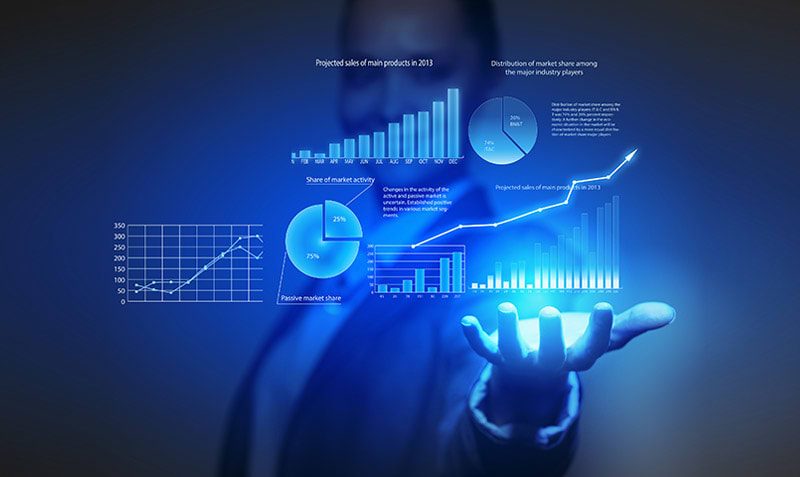To handle diverse IT responsibilities, today’s businesses use a variety of monitoring and management software, including front-end help desk management, infrastructure monitoring, cybersecurity, project management, and Active Directory administration. Every day, each of these applications creates gigabytes of data. Also, it poses a variety of challenges. Hence, we have dedicated this post to address all you need to know about IT analytics, tools, software and other necessary information.
IT analytics
IT analytics are methods to collect, analyze, and report data used in IT operations, management, and strategies to discover complex patterns in IT system availability and large datasets while improving performance and producing real-time business insights. Implementing the various transformational projects that often falls to the IT department will no longer be a hardship or a failure. With the right analytics software, you can manage your data in real-time so as to have up-to-date, useful metrics in order to spot problems early enough and tackle them immediately.
Overview
Within firms, a new set of connections is forming around how workers in data, analytics, IT, and operations teams collaborate. Is there a “correct” method to set up these connections?
The traditional lines of demarcation between the scope of IT and the responsibilities of operating divisions are being blurred by data and analytics. Consider the modern IT department’s fundamental mission: absorbing all of the company’s technology “mess” (sometimes from many departments), creating the requisite competencies, and providing cost savings and efficiency. After completing their original objective, many IT businesses are now focusing on the next step, which is innovation.
Enter data and analytics, which open the door to such creativity. However, data is usually owned by the company, and analytics is valuable only if it is utilized to inform business choices, which are also “owned” by the company. Realigning roles and responsibilities is frequently required for IT to operate in the data and analytics environment.
What is Analytics and why IT is Used?
Finding meaningful patterns in data is the goal of the area of computer science known as analytics, which employs mathematics, statistics, and machine learning. The process of analytics, also known as data analytics, includes sifting through enormous data sets in order to locate, interpret, and communicate new information and understanding.
What Kind of Job is Analytics?
Data pertinent to a firm is analyzed by a business analyst. Management reporting is the process of providing management with data analyses on various business processes. Analyst of corporate strategy: this type of employment will focus on assessing data from across the company and providing advice to management on the organization’s strategic direction.
Is Analytics a Hard Skill?
Although analytical thinking is categorized as a form of soft skill, there are certain hard skills that can help you become a better analyst overall. Data analysis, research, creative problem-solving, and effective communication are all examples of analytical skills.
Is Analytics a Hard Job?
Data analysis is neither a “hard” skill and it is not a “soft” skill; rather, it is a process that incorporates a combination of both of these types of skills. Programming languages such as Python, database tools such as Excel, and data visualization tools such as Tableau are some examples of the technical abilities that a data analyst must possess.
IT Analytics software
IT analytics software is one of the most widely used methods of data analysis. This software, which is specialized in business analytics, will be useful to any data analyst who has to evaluate, monitor, and report on critical results. Self-service, predictive analytics, and complex SQL modes make these solutions adaptable to any level of understanding without requiring extensive IT intervention. Without business intelligence, our list of data IT analytics software would be incomplete, and datapine is one example that meets most of the needs of both novice and advanced users.
#1. Datapine
Datapine is a famous business intelligence program that focuses on giving basic yet powerful analysis features to beginners and advanced users who require a quick and dependable online data analysis solution. You can easily drag and drop your chosen values into datapine’s Analyzer and generate a variety of charts and graphs with an efficient user interface. If you’re a seasoned analyst, you might want to explore using the SQL mode. Which allows you to create your own queries while also allowing you to quickly go back to the visual mode. The predictive analytics forecast engine is another important component. While there are many prediction tools available, datapine offers the best in terms of simplicity and speed. A comprehensive chart will unfold with forecasts after just defining the forecast’s input and output based on supplied data points and chosen model quality.
It’s also worth mentioning how powerful artificial intelligence is becoming an indispensable tool in today’s analysis processes. Neural networks, pattern recognition, and threshold alerts will notify you as soon as a business anomaly arises. So you won’t have to spend time manually analyzing vast amounts of data. Easily share your findings with anyone who needs rapid answers to any type of business query via dashboards or customizable reports.
#2. R-Studio
R is a language created by statisticians and is one of the most used data analyst tools. It was created in 1995 and is now one of the most widely used programs for statistical analysis and data science. It is open-source and runs on a range of platforms, including Windows and macOS. The most prevalent integrated development environment is RStudio. R’s data cleansing, data reduction, and data analysis report output with R markdown features. It makes it an indispensable analytical helper for both general and academic data analysis.
It is made up of a vast ecosystem of over 10,000 packages and extensions that you may browse by category and use to do statistical analyses like regression, conjoint analysis, factor cluster analysis, and so on. R can do complex mathematical operations with a single command. Making it easy to understand for folks who don’t have a lot of programming experience. Because it has an efficient ability to build great visualizations. A number of graphical libraries, such as ggplot and plotly, distinguish this language from others in the statistical community.
R was once mostly used in academia, but it now has applications across industries and huge corporations such as Google, Facebook, Twitter, and Airbnb, to name a few. R has a large and active community, thanks to a large number of researchers, scientists, and statisticians who use it.
#3. Python
Python is quite easy to code to other popular languages like Java, and its syntax is very straightforward to learn, making it popular among customers looking for an open-source solution with simple coding methods. This is in data analysis for crawling, cleaning, modelling, and building analysis algorithms depending on business scenarios. Python is a high-level language that is not susceptible to the computer’s local processor. Thus programmers don’t need to understand the system architecture or manage memory.
Python’s portability is another notable characteristic. It is not necessary to build completely new code because users may just run the code on several operating systems without making any modifications. Python is a highly portable language since programmers may use it on both Windows and Mac OS X. Consequently, is a respected and useable language across industries. The most popular organizations using it being Spotify, Netflix, Dropbox, and Reddit. Python is becoming a recognised authority for advanced analysis procedures, thanks to capabilities like text mining and machine learning.
#4. SQL Console
SQL is a programming language for managing and querying data in relational databases. Therefore, it’s especially good at handling data as a database tool for analysts. It’s one of the analyst tools in numerous business cases and data scenarios. Hence, it’s very popular in the data science community.
The explanation is simple: because most data is in relational databases and you need to access and unlock its value. SQL is a vital component of corporate success, and analysts who master it may give their skill set a competitive edge. Different relational (SQL-based) database management systems exist. Such as MySQL, PostgreSQL, MS SQL, and Oracle, and mastering these data analytics software. This would be immensely valuable to any professional analyst. We’ll concentrate on MySQL Workbench because it’s the most popular.
#5. MySQL Workbench
Analysts use MySQL Workbench to visually design, model and manage databases. Optimize SQL queries, administer MySQL setups, and employ a variety of tools to improve MySQL application performance. It will enable you to create and inspect databases and objects (such as triggers or stored procedures), set up servers, and much more. Backup and recovery, as well as audit data inspection, are all simple tasks. MySQL Workbench is a complete solution for analysts working in relational database administration. And enterprises that need to keep their databases clean and effective, as well as for database migration.
#5. SAS Forecasting
SAS Forecasting for Desktop has established itself as one of the most popular and sophisticated data analysis programs. with a variety of forecasting methodologies such as hierarchical reconciliation, event modeling, what-if analysis, and scenario planning.
Automatic forecasting, scalability, and modeling; an infinite model repository; an easy-to-use GUI; an event-modeling console; and what-if analysis. Data preparation is among the seven major aspects of forecasting procedures that they offer. SAS will automatically select variables based on the variables you enter in the modeling process to generate forecasts to help you figure out what’s going on in your organization.
Furthermore, this data package enables customers to make a huge number of forecasts and automate their procedures by combining the SAS Forecast Server and Visual Forecasting solutions. Since the organization has been around for decades. They have established themselves as predictive analytics authority figures, thus it makes sense to give them a shot.
#6. Erwin data modeler (DM)
In a data warehouse and in the cloud, Erwin DM works with both structured and unstructured data. According to their official website, it’s to “discover, visualize, design, distribute, and standardize high-quality enterprise data assets.” To achieve your business goals and demands, Erwin can assist you in reducing complications and understanding data sources. They also provide automated processes that allow you to develop models and designs automatically, reducing errors and increasing efficiency. This is one of the analyst tools that focuses on data architecture. And allows you to develop logical, conceptual, and physical data models.
Additional features like a single interface for all your data, whether structured or unstructured, in a data warehouse or the cloud. Make this solution very adaptable to your analytical needs. The Erwin data modeler comes in seven different versions. Making it very adaptable for enterprises and analysts who require distinct data modeling functionalities.
Do Data Analysts Do Math?
A solid foundation in mathematics is necessary for success in the field of data analysis, just as it is for any other scientific endeavor. Before beginning training to become a data analyst, it is recommended that you brush up on your math knowledge and, if necessary, make any necessary improvements. Have a look at the following list for some important facets of research:
Do I Need Python for Data Analytics?
It is time for you to make a move, as the need for both data scientists and people who analyze data is expected to expand by more than one thousand percent over the next few years. Learning and being proficient in Python is an absolute must if you want to pursue a career as a data analyst or advance your career to that of a data scientist.
What are the 4 Steps of Data Analytics?
Because of this, it is essential to have an understanding of the four layers of analytics, which are described as descriptive, diagnostic, predictive, and prescriptive respectively.
Descriptive analytics.
Diagnostic analytics.
Predictive analytics.
Prescriptive analytics.
Is SQL a Sufficient Language for Data Analysis?
Knowledge of SQL is also required of data analysts in order for them to comprehend the information contained in relational databases such as Oracle, Microsoft SQL, and MySQL. Learning SQL is absolutely necessary in order to properly prepare and organize data. For example, if analysts need to do analysis using Big Data Tools, then SQL is the language that they need to be familiar with.
FAQ
What are top 3 skills for data analyst?
Essential Skills for Data Analysts
- SQL. SQL, or Structured Query Language, is the ubiquitous industry-standard database language and is possibly the most important skill for data analysts to know. …
- Microsoft Excel.
- Critical Thinking.
- R or Python–Statistical Programming.
- Data Visualization.
- Presentation Skills.
- Machine Learning.
How hard is data analytics?
As I mentioned above, data analytics is not a difficult field to break into because it isn’t highly academic, and you can learn the skills required along the way. This means that you will need to dedicate a couple of hours each week to learn these skills in order to make an effective career transition.
Can I learn Data Analytics on my own?
Yes, you can learn the fundamentals of data analysis on your own. To learn R, a person with programming experience may need only a week of part-time study, while a beginner will likely need closer to three weeks of full-time study. Of course, none of these skills is used in isolation.
Is digital analytics hard?
Web analytics is very hard, in essence, because we deal with very complex data sets, statistical analysis, trying to tie online and offline data together, seasonality, and more. It takes a very smart person to do this well, without making mistakes.






